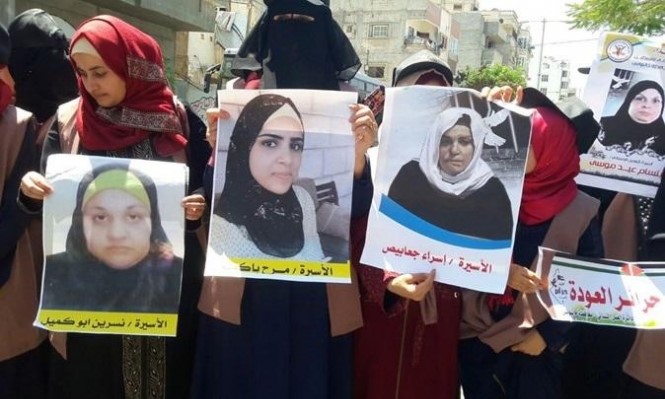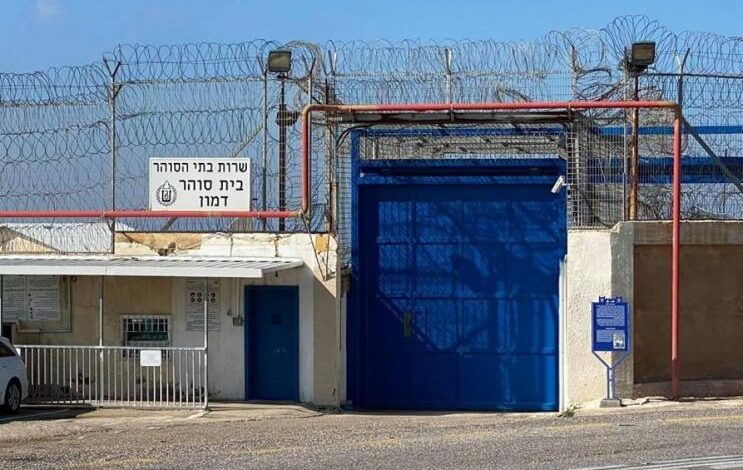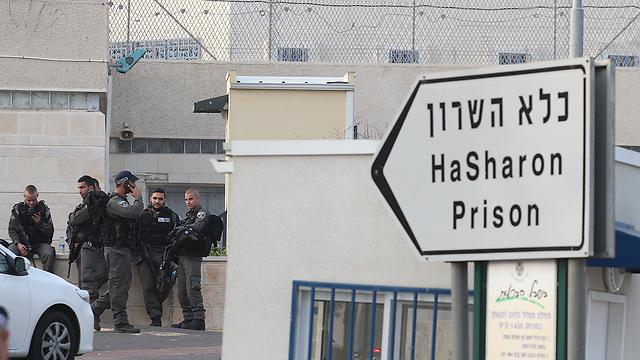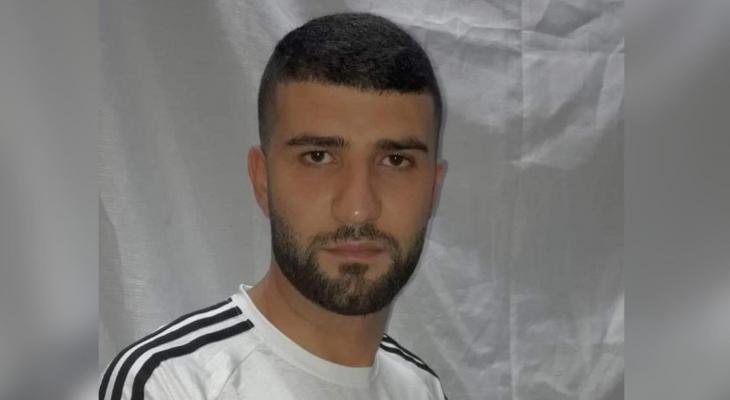
The following article, originally published in Arabic at Etar.info in February 2023, is here translated into English and republished. This article was written by Israa Lafi — Palestinian journalist currently detained without charge or trial in Zionist regime prisons — and Batoul al-Ramahi, a former prisoner released in 2019 after two and a half years imprisoned by the colonial regime. Translation by DZ.
Palestinian Women Prisoners: Femininity and Strength in the Face of Oppression
Israa Lafi
Batoul Al-Ramahi
2023-02-21
As the confrontations between Palestinians and the occupation continue to escalate, the arena of prisoners held by the occupation remains constantly aflame. A few days ago, prisoners were violently repressed in several prisons, especially Negev and Ofer, under the pretext of celebrating the Nabi Yacoub operation carried out by the Jerusalemite martyr Khairy Alqam. Women prisoners in Damon-Haifa prison were also repressed.
This is not the first time Palestinian women prisoners have been repressed. The history of repression is long, both before and after the Wafa al-Ahrar deal in 2011, before and after the merging of women’s detention centers, and before and after separating “security prisoners” from “criminal prisoners.”
Often, the prison administration represses women prisoners for reasons related to their resistance activities or acts of defiance against the occupation. These can include disputes between prisoners and the prison administration, incidents where a guard assaults a prisoner, or prisoners refusing to stand for the count as a form of protest. Guards count prisoners twice daily, and prisoners are required to stand throughout the entire count! Sometimes a prisoner threatens to kill a female guard, for example. In this case, only the cell where the prisoner resides with her companions is repressed, without isolating or punishing the entire section. This is done in an attempt to sow discord among the prisoners. Sometimes the women prisoners are repressed after they take escalatory measures against detention policies in conjunction with men prisoners.
The most intense instances of repression against women prisoners in recent years were in 2017, 2021, and 2023. The repression included: cutting off electricity to the entire section, storming the rooms, assaulting prisoners with beatings and dragging, confiscating all electrical appliances such as the cooking plate, radio, water heater, and television, and locking them in their rooms for days. The repression is accompanied by additional trials for the prisoners, and punitive measures such as isolating some of them, depriving them of family visits, preventing them from commissary, and imposing hefty financial fines.

Repression of 2017
The repression in 2017 occurred after a prisoner refused to stand for the count. The prisoner had refused to stand on three separate occasions and on each occasion, she was punished with temporary solitary confinement. During the fourth time she refused to stand, another prisoner pushed a female guard. The guards then stormed the section, dragged and beat all the prisoners while subjecting some of them to solitary confinement. The prison administration confiscated all the prisoners’ food, their commissary goods, and locked down the section during the holiday.
Repression of 2020[1]
In 2020, the Damon prison administration decided to isolate a prisoner suffering from a difficult psychological condition. The prisoners stood against this decision and prevented the administration from isolating her. The suppression forces entered to forcibly take the prisoner to isolation. The prisoners formed a human shield around her to protect her and prevent her from being taken. Some prisoners were injured due to the guards beating them with batons in an attempt to retrieve the prisoner. The suppression forces failed and withdrew without taking the prisoner to solitary. Afterwards, the prison administration imposed harsh punishments on the prisoners, including cutting off electricity, confiscating electrical appliances: cooking plates, water heaters, television, and radio, as well as closing the cells, preventing the prisoners from going out to the yard for 4 days, and preventing bathing (the bathing section is in an external room and not inside the cells.) The prison administration also threatened to isolate the prisoners’ representative at the time, Bayan Faraoun, and her deputy, Shurooq Dwayyat. The prisoners stood together, hand in hand, to face these punishments. They planned a series of protests against the punishments imposed by the administration. The prisoner movement continued to escalate pressure on the prison administration to lift the lockdown and punishments. They also demanded the right for women prisoners to make phone calls with men prisoners in the occupation prisons. Eventually, the prison administration yielded to their demands.
Repression of 2023
The latest repression occurred after guards found a blade inscribed with “Victory or martyrdom” during a cell search. The administration accused prisoner Yasmin Shaaban of possessing the blade and immediately isolated her. To further complicate matters, the prisoner was isolated outside the prison. In response, a prisoner tried to burn a cell. The prison administration closed the section and isolated a group of prisoners for a period ranging from five to seven days. It deprived them of family visits for a month and deprived the entire section of access to the public phones for a month as well. It’s worth noting that the search and subsequent repression were immediately after Khairy Alqam’s martyrdom operation in occupied Jerusalem.
Skirmishes Outside of Severe Repression
Severe repression is not a frequent occurrence, but there are daily conflicts between prisoners and the prison administration. For example, when merging Sharon prison with Damon, the prison administration deliberately tried to stir up discord among prisoners by spreading rumors and targeting specific rooms with repeated inspections. It also divided the yard time between cells by closing some and opening others, preventing prisoners from gathering.
During these alternating closures, the prisoners’ only option to make consensus decisions or make decisions was to communicate with each other through room windows overlooking the yard area. On rare occasions, written messages were used to briefly clarify the situation. In discussions, options are presented directly, and voting takes place among the prisoners who are authorized to make decisions, even if they are distributed across several cells. Their opinions are gathered in a short time, despite the presence of prison administration listening devices. In cases where prisoners have time and are allowed to communicate, they will meet to discuss and form consensus, meeting once or several times in one of the cells.
Despite the harsh realities of detention, the prisoners have developed a communal structure of organizing that is based on consultation, elections, and collective decision-making. When they decide to escalate against the prison authorities, they prepare meticulously. This preparation includes wearing protective clothing and sturdy shoes, carrying water, and safeguarding important documents like notebooks and papers. For instance, before a planned sit-in protest, anticipating that they might be locked out of their cells, the prisoners were instructed to complete their lunch preparations early and perform their religious ablutions.

The Waiting
Life for women prisoners in detention is dominated by rigid routine. This routine controls every aspect of their existence, turning them into something akin to programmed machines. They are forced to follow fixed procedures, repeated monotonously each day at specific times imposed by the prison administration.
There’s the count during which prisoners are counted inside rooms. This begins at 5:30 AM and is repeated four times during the day at fixed times. There’s the inspection or what’s called (soragim), which is repeated twice a day, when beds and windows are searched, and the cell is fully inspected using a hammer for fear of tunnels or escape attempts. There’s to the break (opening cells with the possibility of moving between them and going out to the section yard) which does not exceed four and a half hours in total distributed over three periods during the day. As for meals, there are three meals brought at fixed times as well (8 AM, 11 AM, and 4 PM) to allow prisoners to prepare food afterwards. This is in addition to the continuous rounds of women guards at night and during cell closure periods, i.e., outside break times.
The life of women prisoners is defined by waiting and hope. These women endure long periods of waiting with anticipation, clinging to hope as they navigate their confinement. They wait for family visits, which vary in frequency: once a month for West Bank prisoners, twice a month for those from Jerusalem and the ’48 interior, and sometimes no visits at all for Gaza prisoners or those punitively denied family contact. Their days are filled with more waiting: for letters and photos from home, for meetings with lawyers, for news updates. They eagerly anticipate prisoner programs and family messages broadcast daily on Palestine Radio and Prisoners’ Radio, or weekly on Ajyal and Holy Quran radios. They wait for court dates, and ultimately, for freedom itself. Yet for some, this final wait ends not in liberation, but (in death) a shroud that extinguishes all their longing and bitter hopes for freedom.
The life of Palestinian women prisoners oscillates between welcoming new prisoners and bidding farewell to those released, between enduring repression and engaging in negotiation, between fighting for their rights and settling into daily routines. Underlying these dynamics is an administrative framework that governs the relationship between prisoners and the prison administration, known within the prison walls as the “internal law.”
The prison environment necessitates a certain degree of communication between prisoners and the prison administration. This is a result of the prisoner movement’s successful demand that the prison service not sidestep them in managing their detention conditions. This principle applies equally to women prisoners. Communication with the administration occurs solely through the section head and her deputy, who are periodically elected by the prisoners. Direct interaction between individual prisoners and the administration or guards within the section is strictly forbidden. The section head and deputy serve as the exclusive intermediaries. Prisoners are barred from visiting the clinic or the prison director’s office unaccompanied; they must be escorted by either the section head or deputy. Conversation during transport to court or hospital is prohibited. Internal regulations also dictate that prisoners refuse to engage with guards without the section head present. These measures aim to prevent the administration from recruiting informants or creating internal dissent through multiple channels of communication. This system became even more rigorous following the merger of Sharon and Damon prisons in late 2018.
The Cooperation Between Women Prisoners and Men Prisoners
Women prisoners actively engage with all struggles carried out by the men prisoners in men’s prisons. They coordinate protest actions through family radio messages, lawyers, and human rights organizations. These intermediaries also relay messages and consensus agreements from men prisoners, often following escalatory steps taken by the men.
In 2019, a groundbreaking event occurred in the history of the Palestinian prisoner movement. Lama Khater became the first woman prisoner elected to the Supreme Leadership Body of Hamas prisoners. This position granted her increased freedom of movement, expanded her ability to work, and allowed her to shape policies related to prisoner’s issues. Her role included communicating with other body members, exchanging messages, staying informed about general policies within the prisons, and sharing tasks and responsibilities.
Khater’s presence in the leadership had a significant impact on women prisoners’ conditions. She facilitated consensus-building among the women and helped formulate agreed-upon rules with representatives from other factions inside the prison. Under the supervision of the Supreme Leadership Body, new regulations were approved governing various organizational matters. These included procedures for electing women prisoner representatives and establishing an advisory council comprising all factions. [2]
The Catalyst
The women’s prison serves as a catalyst, capable of igniting unrest across all men’s prisons. The prison service administration is acutely aware of this dynamic. Any incident within the women’s prison reverberates through the men’s facilities, stirring feelings of chivalry, protectiveness, and fervor among men prisoners. It’s a powder keg – once lit, the consequences are unpredictable!
This was evident in 2021 when women prisoners in Damon were heavily repressed and assaulted. In response, the men prisoners across various facilities revolted, their anger erupting into widespread protests. In an act of solidarity, prisoner Yousef Al-Mabhouh stabbed a guard in Nafha prison, in retribution for the violence against women prisoners.
Unlike men’s prisons, women’s facilities are not sorted based on factional organization. Prisoners are assigned to cells based solely on available space. When Sharon and Damon prisons merged, prisoners were distributed according to mutual agreements. This doesn’t mean there’s a complete absence of organizational affiliations or security-related detentions. Women held on security charges who belong to specific organizations typically receive support from those groups, adhering to their directives without the need for sorting cells based on those organizations.
This situation requires organizations to carefully consider the circumstances of women prisoners when planning any actions or escalations. The prison service often retaliates against women prisoners based on their political affiliations, mirroring punishments in men’s prisons. For instance, in 2019, when Hamas prisoners were denied visits, the same punishment was applied to Hamas-affiliated women in Damon prison.
It was only through coordinated protest actions by women prisoners across various factions – including sit-ins in the prison yard, demanding compensation for those who missed visits, and insistence that men’s prison policies are not applied to women – that this decision was eventually overturned. Without these efforts, the visitation ban would have persisted throughout the duration it was enforced in men’s prisons.
At times, organizational interventions can complicate life for women prisoners. The reality is that the daily existence of women in these prisons doesn’t necessitate engaging in organizational activities, whether for recruitment or confrontation with the occupation.

The Women and Confrontation
One might assume that a woman entering prison is fragile and weak. But this overlooks the transformative power of the detention experience from its very first moments. The need for resilience, self-preservation, and stoic endurance in the face of fear and pain reshapes her.
This transformation goes beyond mere patience. It cultivates a deep-rooted endurance, composure, and the strength to react forcefully to individual provocations, preparing her for the broader confrontations of prison life. She may face the “Nachshon” forces during transport, endure invasive searches by guards, or navigate the challenges of family and lawyer visits.
The woman prisoner exists in a constant state of alertness, safeguarding her dignity, asserting her rights, and resisting physical assault by any means necessary – be it through screams or refusal. Take the case of Estabraq Al-Tamimi, who rejected a strip search before a court appearance. Though severely beaten, her brave stance not only deterred further abuse but inspired her fellow prisoners to collectively refuse naked searches and the degrading practice of double shackling of both hands and feet. The prisoners agreed on a policy that whoever is subjected to such treatment should return to the section and refuse to go out to court.
During times of repression, a profound unity emerges among the women, courage becoming their shared armor. Stripped of societal protections, the woman prisoner acts with the instinct of sacrifice and redemption – like a mother or sister shielding part of her very soul from harm. She may even retaliate against guards or use whatever means available for self-defense.
Yet in the long, cold nights of confinement, she allows herself moments of vulnerability. Tears fall, and prayers ascend. But even in these private moments, her inner strength continues to shine – through letters home that are lovingly crafted for family, in the quiet support offered to fellow prisoners, and in the dignified way she prepares to receive visitors, her voice brimming with hope and vitality despite harshness that she needed in specific situations and to a limited extent, and with what Allah grants her at the time.
The soft-spoken woman may seem to disappear behind the label of ‘prisoner,’ like the setting sun. But she reemerges, radiant as the dawn of freedom. She becomes a beacon of love, hope, and optimism – for her fellow prisoners, for her waiting family, and for the promise of a life reclaimed.
Conclusion
The prisons are like pressure cookers, housing spirits too free to ever truly accept captivity. These women’s hearts dangle precariously on threads of hope, yearning for freedom. Yet even in confinement, their proud voices still sing the melodies of revolution, and their minds remain fertile grounds for resistance. For those committed to the struggle, they will always find ways to resist!
May Allah release their wings, break their chains, and return them to their families and loved ones.
[1] Bayan Faraoun, former prisoner, prisoners’ representative, witness to the repression.
[2] Lama Khater, former prisoner, leadership body member.
Discover more from Samidoun: Palestinian Prisoner Solidarity Network
Subscribe to get the latest posts sent to your email.




